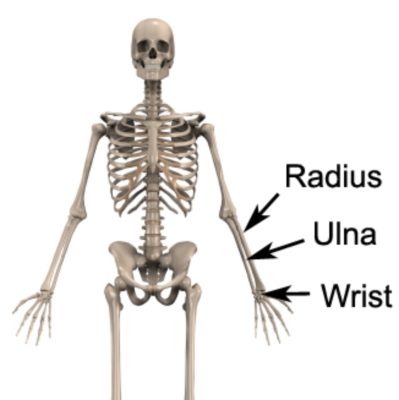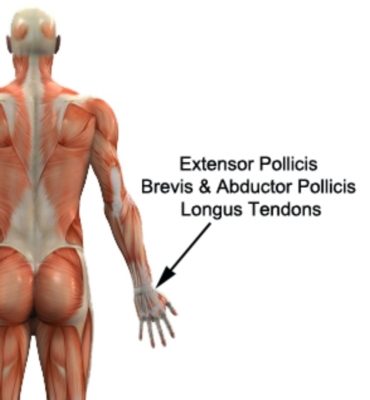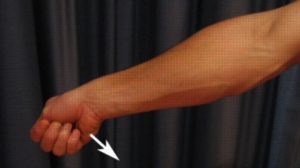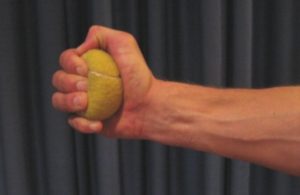De Quervains Tendonitis
Updated:
(Also known as De Quervain’s Tendonitis, De Quervains Tenosynovitis, De Quervains Syndrome)
N.B. Although recent research suggests that ‘ tendinopathy’ is a more appropriate term to describe overuse injuries to tendons, we will use the term ‘ tendonitis’ in this document as it is more widely known.
What is De Quervains tendonitis?
De Quervains tendonitis is a relatively common overuse condition affecting the tendons located at the back / outer aspect of the thumb and is characterized by inflammation and swelling of one or more of these tendons.
The forearm comprises of two long bones known as the radius and the ulna. These bones connect with several small bones at the wrist which in turn connect with the small bones of the fingers and thumb (figure 1). Several muscles controlling thumb movement originate from the back of the forearm (radius and ulna). Two of these muscles are known as the extensor pollicis brevis and abductor pollicis longus and connect to the thumb via their respective tendons (figure 2). The tendons of these muscles cross the back / outer aspect of the wrist to attach to the thumb bones at the back and outer aspect of the thumb. The tendons lie in close proximity to a bony prominence or bump at the thumb side of the wrist. Generally, these two muscles are responsible for taking the thumb backwards or away from the other fingers. They also assist with gripping activity and general use of the thumb.


During contraction of these thumb muscles, tension is placed through their respective tendons. In addition, the tendons may rub against the bony prominence situated at the thumb side of the wrist. When these forces are excessive, due to too much repetition or high force, damage to the tendons may occur. De Quervains tendonitis is a condition whereby there is damage, with subsequent inflammation and degeneration to one or more tendons at the back / outer aspect of the thumb. This is usually due to gradual wear and tear associated with overuse and may affect the extensor pollicis brevis and / or the abductor pollicis longus tendon. Occasionally it may occur traumatically due to a specific incident.
Causes of De Quervains tendonitis
De Quervains tendonitis most commonly occurs due to repetitive or prolonged activities placing strain on the tendons at the back / outer aspect of the thumb. These activities may include sports such as golf, racquet sports, ten pin bowling, rowing or canoing, as well as manual work, such as carpentry, painting, chopping wood, bricklaying, repetitive use of a hammer or screw driver, use of vibrating machinery, sewing and knitting, writing or working at a computer. De Quervains tendonitis may also occur from other activities involving forceful or repetitive gripping of the hand and thumb.
It is common for patients to develop this condition following a sudden increase in activity that places stress on the thumb tendons or due to a change in these activities. Occasionally, De Quervains tendonitis may develop suddenly. This can be due to a direct blow to the back of the thumb and wrist, a fall or due to a forceful movement involving heavy lifting or a gripping force through the thumb tendons. A history of thumb, wrist, elbow, shoulder, neck or upper back injury may increase the likelihood of a patient developing this condition.
Signs and symptoms of De Quervains tendonitis
The symptoms associated with this condition usually develop gradually over a period of time. Initially, symptoms may present as an ache or stiffness in the back of the wrist and thumb following an aggravating or unaccustomed activity. This may often be felt at night or first thing in the morning and may warm up with heat and movement in the early stages. As the condition progresses, pain may be felt with every day activities involving the wrist and thumb such as carrying groceries, opening a jar, cooking or using the computer. Patients with De Quervains tendonitis may also experience swelling, crepitus or pain on firmly touching the affected thumb tendons.
Occasionally, pins and needles or numbness in the thumb may be experienced along with weakness in the wrist, hand and thumb. This may present as difficulty performing fine movements of the hand, reduced grip strength, or an increased frequency of dropping objects. De Quervains tendonitis may also be associated with neck or upper back pain on the same side.
Diagnosis of De Quervains tendonitis
A thorough subjective and objective examination from a physiotherapist may be sufficient to diagnose De Quervains tendonitis. Further investigations such as an X-ray, Ultrasound, MRI or CT scan may be required to assist with diagnosis and assess the severity of the condition.
Treatment for De Quervains tendonitis
Most cases of De Quervains tendonitis settle well with appropriate physiotherapy. The success rate of treatment is largely dictated by patient compliance. One of the key components of treatment is that the patient rests sufficiently from any activity that increases their pain until they are symptom free. Activities which place large amounts of stress through the thumb tendons should be minimized, these may include: sports such as golf, racquet sports, ten pin bowling, rowing or canoeing, general gripping activities, carrying or lifting. Resting from aggravating activities ensures that the body can begin the healing process in the absence of further tissue damage. Once the patient can perform these activities pain free, a gradual return to these activities is indicated provided there is no increase in symptoms.
Ignoring symptoms or adopting a ‘no pain, no gain’ attitude is likely to lead to the problem becoming chronic. Immediate, appropriate treatment in patients with this condition is essential to ensure a speedy recovery. Once the condition is chronic, healing slows significantly resulting in markedly increased recovery times and an increased likelihood of future recurrence.
Patients with De Quervains tendonitis will usually benefit from following the R.I.C.E. Regime. The R.I.C.E regime is beneficial in the initial phase of the injury (first 72 hours) or when inflammatory signs are present (i.e. morning pain or pain with rest). This involves resting from aggravating activities (often with the use of a Thumb Brace or splint), regular icing, the use of a compression bandage and keeping the arm elevated. Anti-inflammatory medication may also hasten the healing process by reducing the pain and swelling associated with inflammation.
Manual “hands-on” therapy from the physiotherapist such as massage, trigger point releases, joint mobilisation to the wrist, thumb and hand, dry needling, stretches and electrotherapy can also assist with hastening healing and improving flexibility and function in patients with De Quervains tendonitis.
Patients with De Quervains tendonitis should perform pain free flexibility and strengthening exercises as part of their rehabilitation to ensure an optimal outcome. The treating physiotherapist can advise which exercises are most appropriate for the patient and when they should be commenced.
In the final stages of rehabilitation, a gradual return to activity or sport is indicated as guided by the treating physiotherapist provided there is no increase in symptoms. A ‘pen build up’ to increase the diameter of a pen may be useful for those patients who need to return to writing activities.
Prognosis of De Quervains tendonitis
With appropriate management and physiotherapy, most minor cases of De Quervains tendonitis that have not been present for long can usually recover within a few weeks. In more severe and chronic cases, recovery can be a lengthy process and may take more than 6 months in those who have had their condition for a long period of time. Early physiotherapy intervention is therefore vital to hasten recovery. In rare cases that do not respond to conservative treatment, surgery or other interventions may be indicated.
Contributing factors to the development of De Quervains tendonitis
There are several factors which can predispose patients to developing this condition. These need to be assessed and corrected with direction from a physiotherapist. Some of these factors may include:
- excessive training or activity
- muscle weakness
- muscle tightness
- joint stiffness
- poor sporting technique or equipment
- poor posture or ergonomic set-up
- inadequate warm-up
- Injury to the neck, upper back or nerves
Physiotherapy for De Quervains tendonitis
Physiotherapy treatment for De Quervains tendonitis is vital to hasten the healing process, ensure an optimal outcome and decrease the likelihood of future recurrence. Treatment may comprise:
- soft tissue massage
- electrotherapy
- thumb bracing or splinting
- thumb taping
- joint mobilization
- dry needling
- ice or heat treatment
- exercises to improve flexibility and strength
- education
- training and activity modification advice
- technique correction
- anti-inflammatory advice
- devising an appropriate return to activity plan
Other intervention for De Quervains tendonitis
Despite appropriate physiotherapy management, some patients with De Quervains tendonitis may not improve adequately. When this occurs the treating physiotherapist or doctor can advise on the best course of management. This may include further investigations such as X-rays, ultrasound, MRI or CT scan, pharmaceutical intervention, corticosteroid injection, autologous blood injection or referral to appropriate medical authorities who can advise on any intervention that may be appropriate to improve the condition. In rare cases, surgical intervention may be indicated.
Exercises for De Quervains tendonitis
The following exercises are commonly prescribed to patients with De Quervains tendonitis. You should discuss the suitability of these exercises with your physiotherapist prior to beginning them. Generally, they should be performed 3 times daily and only provided they do not cause or increase symptoms during the exercises or after with rest.
EPL Stretch
Begin with your elbow straight and your fingers curled up around your thumb (figure 3). Slowly and gently bend your wrist towards the little finger side as far as you can go without pain and provided you feel no more than a mild to moderate stretch. Hold for a second or two and repeat 5-10 times provided there is no increase in symptoms during the exercise or after the exercise with rest.

Tennis Ball Squeeze
Begin this exercise holding a tennis ball (figure 4). Squeeze the tennis ball gently (at approximately 1/3 of a maximal contraction) provided there is no increase in pain. Hold for 20 seconds and repeat 3 times ensuring there is no increase in symptoms during the exercise or after the exercise with rest. Once you can consistently perform this exercise for a few consecutive days without pain, the exercise can be progressed by slowly building up the intensity of contraction over a number of days or weeks (until you can eventually squeeze the ball at a maximal contraction) provided there is no increase in symptoms.

Physiotherapy products for De Quervains tendonitis
Some of the most commonly recommended products by physiotherapists to hasten healing and speed recovery in patients with De Quervains tendonitis include:
- Thumb Braces or Thumb Splints
- Sports Tape (for protective taping)
- Ice Packs and Heat Packs
- TENS Machines (for pain relief)
To purchase physiotherapy products for De Quervains tendonitis, click on one of the above links or visit the PhysioAdvisor Shop.
More information
- View more Wrist & Hand Stretches.
- View more Wrist & Hand Strengthening Exercises.
- View Thumb Taping.
Find a Physio for De Quervains tendonitis
Find a Physiotherapist in your local area who can treat De Quervains tendonitis.

Link to this Page
If you would like to link to this article on your website, simply copy the code below and add it to your page:
<a href="https://physioadvisor.com.au/injuries/wrist-hand/de-quervains-tendonitis”>De Quervains Tendonitis – PhysioAdvisor.com</a><br/>PhysioAdvisor offers detailed physiotherapy information on De Quervains tendonitis including: causes, symptoms, diagnosis, treatment, exercises, physiotherapy products and more...
Return to the top of De Quervains Tendonitis.
